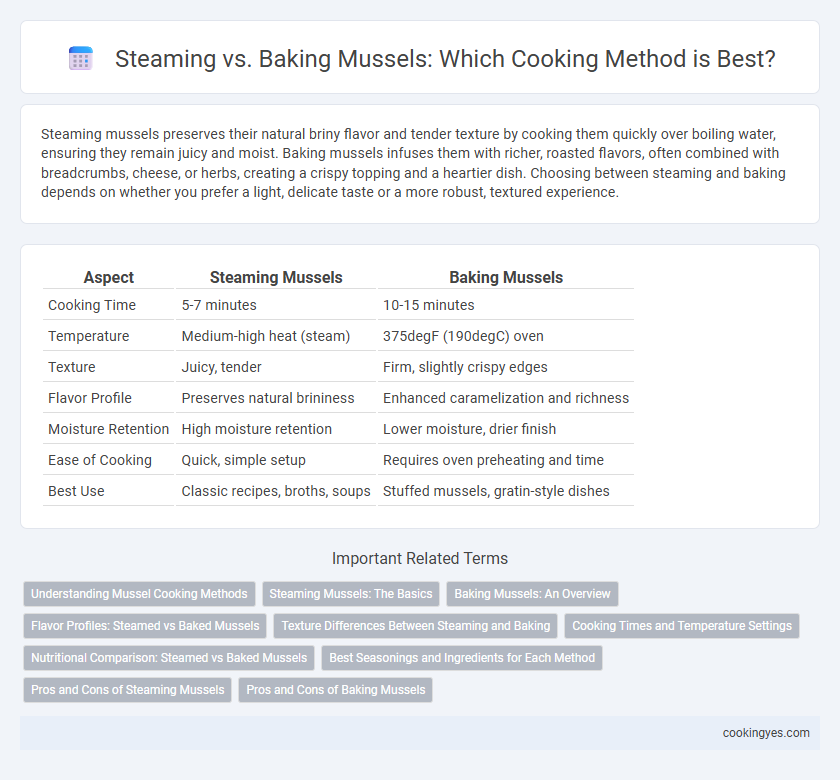Steaming mussels preserves their natural briny flavor and tender texture by cooking them quickly over boiling water, ensuring they remain juicy and moist. Baking mussels infuses them with richer, roasted flavors, often combined with breadcrumbs, cheese, or herbs, creating a crispy topping and a heartier dish. Choosing between steaming and baking depends on whether you prefer a light, delicate taste or a more robust, textured experience.
Table of Comparison
| Aspect | Steaming Mussels | Baking Mussels |
|---|---|---|
| Cooking Time | 5-7 minutes | 10-15 minutes |
| Temperature | Medium-high heat (steam) | 375degF (190degC) oven |
| Texture | Juicy, tender | Firm, slightly crispy edges |
| Flavor Profile | Preserves natural brininess | Enhanced caramelization and richness |
| Moisture Retention | High moisture retention | Lower moisture, drier finish |
| Ease of Cooking | Quick, simple setup | Requires oven preheating and time |
| Best Use | Classic recipes, broths, soups | Stuffed mussels, gratin-style dishes |
Understanding Mussel Cooking Methods
Steaming mussels preserves their natural briny flavor and tender texture by cooking them quickly with minimal added ingredients, typically in a covered pot with wine or broth. Baking mussels introduces a richer, often more complex flavor profile by allowing toppings like garlic, herbs, and cheese to meld while the heat intensifies, resulting in a slightly firmer texture. Choosing between steaming and baking depends on desired taste and texture, with steaming offering freshness and baking providing a savory, robust experience.
Steaming Mussels: The Basics
Steaming mussels is the preferred cooking method to preserve their natural juices and enhance flavor while ensuring even heat distribution. This technique typically involves placing mussels in a pot with a small amount of liquid, such as water, wine, or broth, and covering them until they open, which usually takes 5-7 minutes. Steaming retains the mussels' tender texture and allows the infusion of aromatic ingredients like garlic, herbs, and white wine, making it a popular choice among chefs and home cooks alike.
Baking Mussels: An Overview
Baking mussels enhances their natural briny flavor while allowing for even cooking and a tender texture. This method often involves topping mussels with garlic, herbs, breadcrumbs, or cheese, creating a savory crust that complements the succulent interior. Baking at around 375degF (190degC) for 10-15 minutes ensures thorough cooking without drying out the shellfish, making it a popular choice for flavorful seafood dishes.
Flavor Profiles: Steamed vs Baked Mussels
Steaming mussels preserves their natural briny flavor and tender texture, resulting in a delicate, ocean-fresh taste enhanced by the infused herbs or broth. Baking mussels imparts a richer, more concentrated flavor as the dry heat intensifies the shellfish's sweetness, often complemented by toppings like garlic, cheese, or breadcrumbs. Both methods enhance mussels' unique taste but steaming emphasizes freshness, while baking delivers a robust, savory profile.
Texture Differences Between Steaming and Baking
Steaming mussels preserves their natural tenderness and juiciness, resulting in a plump, soft texture that highlights their delicate flavor. Baking mussels creates a firmer, chewier texture with slightly caramelized edges due to dry heat exposure. The choice between steaming and baking directly influences the mussels' texture, with steaming offering a more succulent bite and baking delivering a meatier, more robust mouthfeel.
Cooking Times and Temperature Settings
Steaming mussels typically requires 5 to 7 minutes at a temperature of around 212degF (100degC), ensuring the shells open quickly while preserving moisture and tenderness. Baking mussels involves cooking at a higher temperature, usually 375degF (190degC), for about 10 to 15 minutes, which can produce a firmer texture and enhanced flavors through caramelization. Optimal cooking times and temperatures depend on the desired texture and recipe, with steaming favored for juiciness and baking for a roasted finish.
Nutritional Comparison: Steamed vs Baked Mussels
Steamed mussels retain more water-soluble vitamins such as B12 and C due to the gentle cooking process, preserving higher nutrient levels compared to baking. Baking mussels can slightly reduce their vitamin content but may enhance mineral availability, including iron and zinc, through Maillard reactions. Both methods maintain high protein content and omega-3 fatty acids, essential for heart health, with steaming offering a slight edge in preserving overall nutritional integrity.
Best Seasonings and Ingredients for Each Method
Steaming mussels enhances their natural briny flavor when paired with classic seasonings like garlic, white wine, fresh parsley, and lemon, which infuse the shellfish with aromatic, bright notes. Baking mussels works well with richer ingredients such as garlic butter, Parmesan cheese, breadcrumbs, and herbs like thyme or oregano, creating a savory, crispy topping that complements the tender meat. Choosing steaming or baking depends on the desired flavor profile--steaming highlights freshness and subtlety, while baking adds a hearty, flavorful crust.
Pros and Cons of Steaming Mussels
Steaming mussels preserves their natural flavors and ensures tender, juicy meat by cooking them quickly with minimal liquid, which also helps retain nutrients like zinc and iron. This method allows for easy temperature control and reduces the risk of overcooking, but it requires a tightly sealed pot to trap steam and can sometimes result in uneven cooking if mussels are overcrowded. However, steaming may limit flavor infusion compared to baking, as it offers less opportunity for browning or incorporating additional spices and ingredients.
Pros and Cons of Baking Mussels
Baking mussels provides a crispy texture and allows for rich flavor absorption from toppings like breadcrumbs, garlic, and herbs, enhancing the overall taste experience. However, baking can lead to uneven cooking and potentially overcooked, rubbery mussels if not carefully monitored. This method is less energy-efficient compared to steaming and may require longer cooking times, which can diminish the delicate natural flavor of fresh mussels.
Steaming vs Baking for cooking mussels Infographic

 cookingyes.com
cookingyes.com